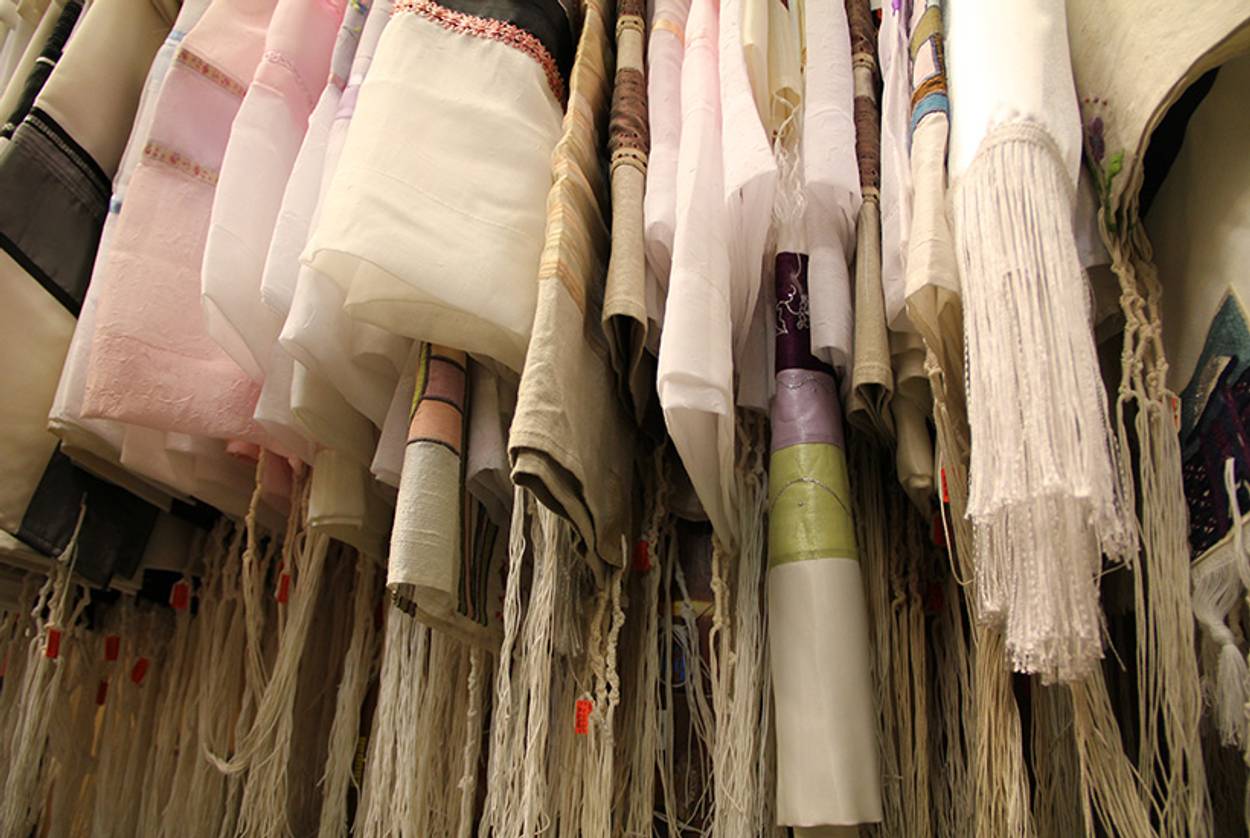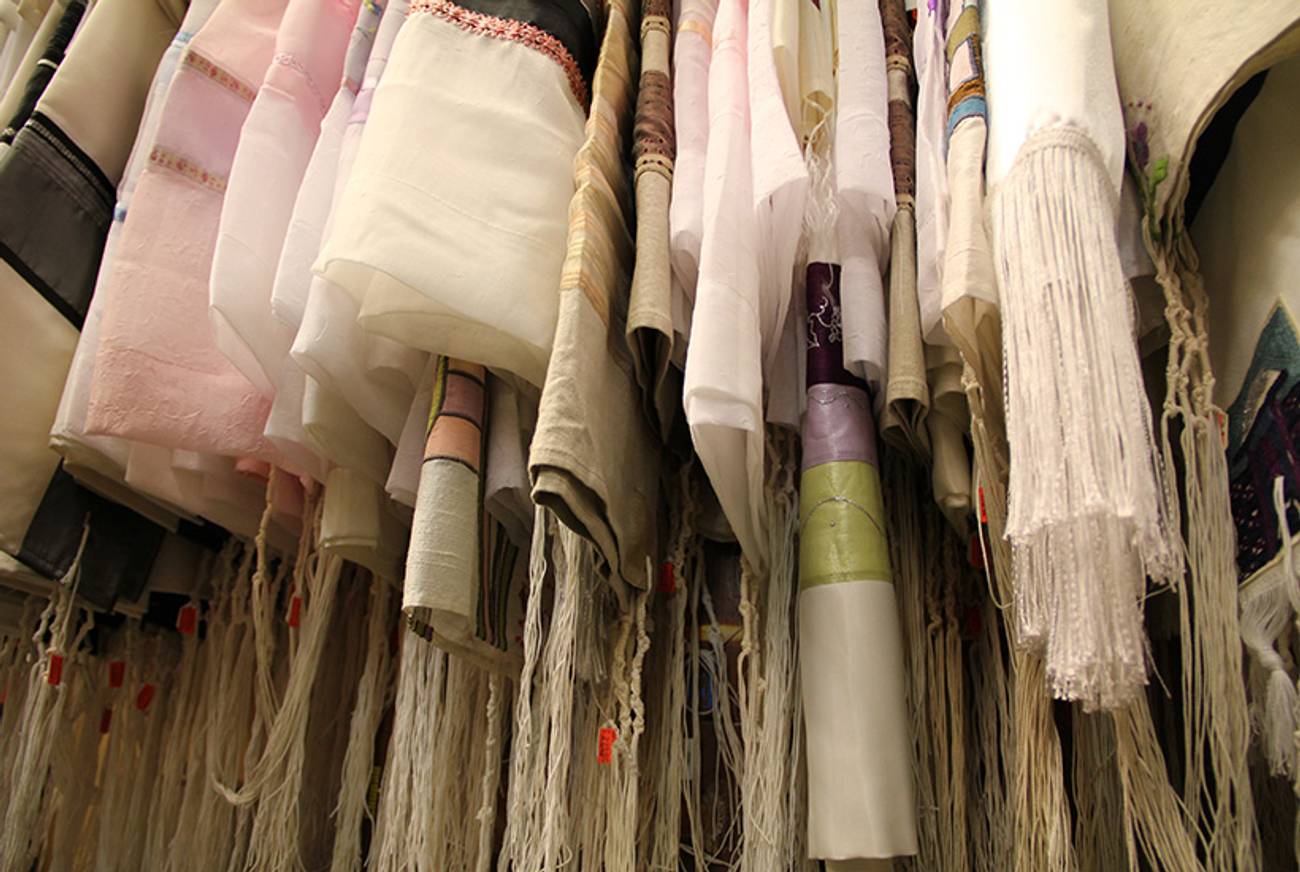How Buying a Tallit at 46 Helped Me Claim My Place in the Jewish Community
I’ve struggled for decades to feel comfortable in synagogue as a single woman. Wrapped in a silk prayer shawl, I finally felt at home.




I sneaked into West Side Judaica in Manhattan on a sunny afternoon two years ago and stealthily made a beeline for the tallit section in the back, where I found a rack for women. I tried on colorful ones—not me. Embroidered ones—again, no. I wanted a more traditional tallit, one that I could hide inside, one that felt like Jerusalem on a cold, rainy day. Finally, I settled on a beautiful silk one with silver threads that had been made by an Israeli manufacturer. It seemed a little big, but I’m five feet tall—that’s often the case for things I buy.
I put it on over my shoulders, then pulled it off over my head. I repeated this many times, until I was afraid that the strings of the tzitzit would become tangled, that I would accidentally step on them, that someone would chastise me for breaking some religious rule that I wasn’t even aware of. But no such thing happened. When I finally emerged from the back corner, the Orthodox man who ran the store was very nice. He folded the one I had chosen, asked me a few polite questions, and sent me on my way with my very first tallit.
I carried my package home gently, afraid that I would do something wrong. The tallit came with its own woven case, but that, too, seemed rather fragile. Fragile: like spirituality itself. Fragile: like my inchoate connection to the Jewish community.
I had decided to buy the tallit for my niece’s bat mitzvah the following week. I’d be getting an aliyah, and would be required to wear one. I could have simply borrowed one from the synagogue, but I liked the idea of having my own for the first time, at age 46.
I grew up at a time when women did not wear tallitot. When I was my niece’s age, I had to fight to be the first girl in my congregation to have a bat mitzvah on a Saturday. I didn’t wear a tallit, but I read the Torah and Haftorah, and that was enough to make some of the more traditional families drop out of our Conservative synagogue in suburban New Jersey. I was proud of myself for sticking to Saturday, for digging in my heels. I was self-assured that weekend, in my long green bat mitzvah dress, singing off-key and following the trops for my Torah portion, B’reishit, as best I could. I thought then that claiming my place that day was the end of the battle to find a place where I felt comfortable in the Jewish community. But it was just the beginning.
***
After breaking up with the man I planned to marry in my 20s, I didn’t meet anyone else I wanted to create a life with. My life was full, perhaps more so than if I had settled down that young, but as friends married and had children, I often found myself at services alone. And as the shmoozy services of my childhood gave way to a space of prayer and singing, somehow, I felt, I found myself closer to God.
For years after leaving home at 17, I’d alternated between sloughing off my Jewish identity and struggling to recreate it in a way that seemed relevant. I rebelled against the right-wing politics and hierarchy of religiousness of the synagogue that I’d grown up in, but I missed having Friday night dinners with challah and wine and being part of a Jewish community. I studied Hebrew in college and spent six months in Israel then, and another summer there working during graduate school, yet I had no interest in making aliyah, as some of my friends from that time would.
By the time I’d finished grad school and begun working at a business magazine in New York, I felt increasingly drawn to intellectual and cultural Jewish experiences, while remaining alienated from religious ones. I was moved by Yehuda Amichai’s poetry, and A.B. Yehoshua’s novels, and for a time was obsessed with Susannah Heschel’s On Being a Jewish Feminist. But I was in my mid-30s and had lived in New York for more than a decade before it even occurred to me to join a synagogue.
In part, these contradictions ran through my family. My grandfather, whom I adored, was steeped in Jewish tradition and culture and with my grandmother founded a Jewish summer camp, but by the time of his death he was pretty much an atheist. In part, too, I just didn’t know where I belonged, and finding spirituality in the meditation of a yoga class was easier than figuring it out.
The Upper West Side synagogue I ultimately joined, 10 years ago, is unaffiliated, and in practice it lies somewhere between Reform and Conservative: One of the three rabbis is a woman a few years younger than me who had chosen to become a mom on her own. Women are a full and equal part of the community, and I have always felt comfortable in that community. Many women wear tallitot. Eventually, I joined them, donning one for High Holiday services—although I always borrowed it from the synagogue.
I felt like an imposter the first time I put one on for Rosh Hashanah services some five years ago. Just taking the tallit off the rack by the door felt transgressive. I wasn’t sure how to wrap myself in it, or what to do with it. I wanted to claim the ritual, yet I wondered if these practical aspects were passed down from fathers to sons, leaving me perpetually on the outside. But as I got more used to wearing one each year, I grew to like it. Putting on the tallit made me feel more equal, more part of the service. I felt as if I belonged: When I had one on, I even felt that I could sing a little louder.
Still, borrowing a tallit and choosing to own one are two very different things. So, perhaps I should have known that buying a tallit would awaken every insecurity about my place within the Jewish community, which doesn’t quite know what to do with women like me: over 40, never married, childless. And it would play into the regrets that I had about having wound up in this place.
But I also knew that I had spent most of my adult life taking apart my own complicated relationship with Judaism and piecing it back together. And that, for me, buying a tallit was just part of the continuum that started when I insisted on being bat mitzvah on Saturday rather than Friday.
***
My niece wore a purple woven tallit, stylish in a Judaism-meets-Woodstock kind of way, at her bat mitzvah. Having grown up in a Reconstructionist synagogue, where High Holiday services were held outdoors under a big tent, she seemed completely at ease wearing it. My sister—her mother— wore a more conservative tallit, an off-white woven one with a matching woven kippah.
I wore my new silk tallit, draping it over my velvet dress, covering my shoulders, hiding within it. I had taught myself the prayer for putting on the tallit, literally, from listening to the song “Michal” by Galeet Dardashti, a modern Sephardic singer descended from a line of cantors from Iran. The song weaves together the stories of the singer’s great-aunt, who wore tallit and tefillin, with a midrash about King Saul’s daughter Michal laying tefillin to no objection from the rabbis of the day. Dardashti once said in an interview: “My father asked [my great-aunt], ‘why do you pray like a man?’ ‘God did not bless me with children of my own. So I pray as I believe God would expect me to.’ So here she is, making her own drash.” This song—and this reasoning—had stuck with me, strongly, as a single woman, over 40, with no kids of my own. I listened to that song over and over again and chose to say the prayer over the tallit, like Michal, despite whatever differences of opinion remained thousands of years later over whether women—neither commanded to wear tzitzit, as the prayer states, nor prohibited from it—should do so.
I wore my tallit again at High Holidays that fall, walking into synagogue alone for services, taking my place, saying the prayer, and wrapping myself in the tallit. On Yom Kippur, I sat between a woman slightly younger than me and an older woman, both also alone. My friends were busy with their children, or had been assigned to different locations—a particular New York problem for a synagogue with more members than space. And so these two women and I helped each other to find the right place in the prayer book. We prayed together, though we had never met, and felt no need to introduce ourselves. My tallit made me feel part of that service in a way that lacking it had not. Can a prayer shawl facilitate prayer? Does the draping it, blessing it, and putting it on make a difference? That day, in that service, at least, it did.
During the Aleinu Gadol prayer—where for the past few years, in keeping with the traditions of the synagogue to which I now belong, I would join the congregants in the aisles to prostrate myself—I pulled the tallit over my head. I was in my own space, with God, or without, I’m never quite sure, in my own tabernacle of peace, where I could cry or pray or just be. I knelt with the tallit over my head, then lay down on the floor, one woman among many women and men similarly covered. The new year had begun, the gates were closing, and I, wrapped in my own tallit, was ready to claim my space within it.
***
You can help support Tablet’s unique brand of Jewish journalism. Click here to donate today.
Amy Feldman is a New York-based journalist and writer. Her work has appeared in Barron’s, Fortune, Reuters, the New York Times, and other publications.
Amy Feldman is a New York-based journalist and writer. Her work has appeared in Barron’s, Fortune, Reuters, the New York Times, and other publications.